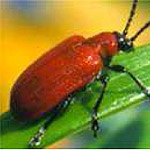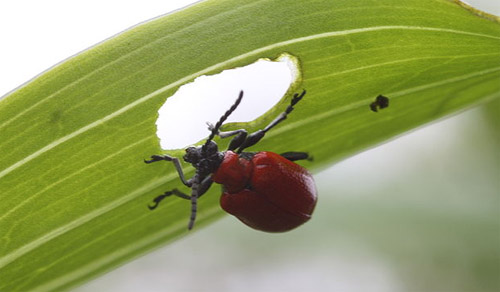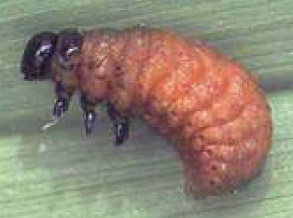Lily Leaf Beetle
 Lilioceris lilli
Lilioceris lilli
The Lily Leaf Beetle is native to Europe and North Africa. It is found in Quebec and Ontario and has also been reported in the Portage la Prairie area.
Description
The beetle is 6-8 mm in length. Its shiny bright red wing covers contrast to the beetle's black antennae, eyes, head, legs and underside. It has 11 segmented antennae, notched eyes and two visible indentations on the thorax. It may chirp when squeezed lightly.

Impact
The beetle's favorite foods are true Lilies (lilium) as well as fritillaries. It does not attack day Lilies (hemerocallis). The most damage is done by feeding larvae in spring and later on by the adult beetles. Left alone to feed, they will defoliate Lily plants, causing them to be less vigorous the next year.
Habitat
Adult beetles over-winter in the soil and plant debris, and in early spring, the adults emerge to mate and lay eggs. The female lays between 200 and 300 eggs on the underside of leaves in clumps or irregular rows of 2-10 eggs. The tiny eggs are a dull-orange color. Hatch occurs in five to ten days after which the larvae feed heavily for 16 - 24 days, growing rapidly to twice the size of their parents.
 The newly hatched larvae feed on the bottom of the leaves while mature larvae feed on the top of theleaves. The young larvae cover themselves with a layer of sticky mud like excrement to protect themselves against predators.
The newly hatched larvae feed on the bottom of the leaves while mature larvae feed on the top of theleaves. The young larvae cover themselves with a layer of sticky mud like excrement to protect themselves against predators.
At maturity, larvae either drop or crawl to the ground where they pupate in secreted cocoons. In under 25 days, a fully mature adult emerges to repeat the process anew. There can be 2-3 generations a year and in some cases the adult female can over-winter and lay a clutch of eggs the following season.
Control
The Lily beetle has no natural enemies in Canada. There are several methods of control.
- Squash the larvae with gloved fingers.
- Knock the adults into a jar of soapy water.
- Natural pesticides such as NEEM, PYRETHRIN or ROTENONE. These are most effective in the larval stage.
- Insecticides such as Sevin or Malathion.
Provided by: Manitoba Regional Lily Society, 2006
Â
© Copyright 2004-2025 - CMS Made Simple
This site is powered by CMS Made Simple version 1.4.1


